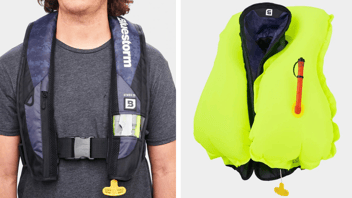Bluestorm™ inflatables have a long history of quality and engineering that meets or exceeds U.S. Coast Guard approval. Each inflatable life jacket air chamber is inflated and tested for leaks before it leaves our factory. We use U.S. manufactured Halkey Roberts® inflator mechanisms that are also tested to meet or exceed the standards set by U.S. Coast Guard.
It’s important to remember you are responsible for the care and maintenance of your Bluestorm™ inflatable to keep it safely performing when needed. Please remember to read the instruction manual included with your life jacket for proper care and maintenance. If you have lost your instruction manual, you can download them here for free.
Inspections
As a general rule of thumb, you should always check that your inflatable life jacket is in good and serviceable condition before every season or outing. Perform “beginning of season maintenance” every two-to-three months for light to moderate users or more often if used frequently or in a humid climate.
Check that it’s free of rips, tears, or holes and that all seams are securely sewn. Likewise, ensure that the fabric, straps, and hardware still hold strong.
How to inspect your Bluestorm™ inflatable life jacket
-
Remove the CO2 cylinder and bobbin.
-
Visually inspect the device for abrasions, rips, tears, and punctures. Inspect the outer shell by “pinching” the fabric. It should not fray or tear. Life jackets with fabric that has faded, torn, or deteriorated should be removed from service and replaced.
-
Perform a leakage test by orally inflating the chamber until firm. Let the device stand overnight to ensure enough time has passed to make a judgment. If a loss of air occurs, repeat the process to validate the result. If the leak persists, remove the life jacket from service and replace the device.
-
Confirm the oral inflation valve is properly functioning by inflating the device and holding the valve underwater. If bubbles appear, repeat the process to validate the result. If a leak occurs, remove the life jacket from service and replace the device.
-
Inspect the bobbin by looking for the white, water-soluble substance located within the bobbin. Check to make sure the white substance is still intact with no signs of cracks or breaks. Replace the bobbin if the manufacture date is over three years from the date of inspection.
-
Inspect the CO2 cylinder for any holes or piercings near the face of the cylinder. Be sure to look for signs of rust or corrosion as well and replace if needed.
-
For 1F & 3F models (bayonet style CO2), inspect the sensor ring. If broken, replace the cylinder.
-
Follow repacking and re-arming instructions.
cleaning
Cleaning your inflatable life jacket is simple, but be sure to consult your owner’s manual beforehand for unique cleaning procedures depending on the material used. In most cases, you should always hand wash your PFD in clear water with non-toxic soap and hang it to dry. Avoid using harsh chemical or solvent-based cleaners with bleach or other toxins that could damage the material.
How to clean your Bluestorm™ inflatable life jacket
-
Remove the CO2 cylinder and bobbin.
-
Handwash in warm soapy water using mild detergent.
-
Rinse thoroughly with clean water.
-
Hang dry in a well-ventilated area away from direct sunlight or heat sources.
-
Ensure the life jacket is completely dry before re-arming, repacking, or stowing away.
Storage
You’ll want to store your inflatable life jacket in a well-ventilated area away from direct sunlight when you’re not using it. It’s best to avoid storing an inflatable in hot, cold, or damp places to avoid molding or CO2 corrosion. The gas in a CO2 cartridge expands in hot weather and contracts in cold weather which can affect the level of buoyancy in an emergency.
How to store your Bluestorm™ inflatable life jacket
-
Remove the CO2 cylinder and automatic bobbin if stored for a long period of time.
-
Ensure your inflatable is clean and dry.
-
Hang and store in a well-ventilated area away from direct sunlight, heat, or cold and damp places.
additional resources
Check out Bluestorm™ inflatable PFDs, rearming kits, and maintenance checklists for additional security on the water. Contact us with any questions.




